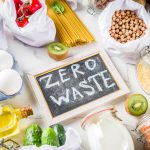Small steps, big impact: 6 BRILLIANT ways to reduce food waste in your home
 (NaturalHealth365) How’s this for a jaw-dropping figure: according to the U.S. Department of Agriculture (USDA), more than a third of all available food produced for humans ends up wasted or spoiled. It’s not hard to imagine how this large amount of food waste can contribute to issues such as food security, hunger, and even economic prosperity. But the environmental impact of food waste can no longer be ignored either.
(NaturalHealth365) How’s this for a jaw-dropping figure: according to the U.S. Department of Agriculture (USDA), more than a third of all available food produced for humans ends up wasted or spoiled. It’s not hard to imagine how this large amount of food waste can contribute to issues such as food security, hunger, and even economic prosperity. But the environmental impact of food waste can no longer be ignored either.
From the proliferation of greenhouse gases to wasted water, our bad habit of throwing away food could be threatening our planet on a global scale. The good news is, meaningful change can start locally — even within your own home.
Food waste harms the environment in multiple ways, creates issues on a global scale
Why do we waste food anyway? Researchers have discovered several possible factors:
- Labor shortages
- Food recalls
- Insufficient production skills
- Inadequate infrastructure
- Natural disasters
- Poor consumer practices
We’ve even seen dramatic and horrifying examples of food waste during the COVID pandemic due to supply chain interruptions and economic lockdowns that forced restaurants to shut their doors for so long.
Experts agree that addressing all these food waste factors will require a comprehensive, multidisciplinary approach — and something clearly needs to be done. According to the Food and Agricultural Organizations of the United Nations, the cost of food waste in America is about $1 trillion every year. Americans are wasting hundreds to thousands of their own hard-earned dollars on food that they end up throwing away …. unfortunately, to the direct and indirect harm to the surrounding environment.
For one thing, the amount of natural resources and energy required to process, transport, store, and cook food is considerable — these are resources that could be conserved were they not to go to spoiled or tossed out food. Agriculture alone accounts for about 70 percent of the water used in the world — which means that wasted food also means wasted water.
Need a better example? Nonprofit organization Move for Hunger reports that throwing away just one kilogram of beef is equivalent to wasting 50,000 liters of water used to produce that meat. Likewise, throwing out just one glass of milk is not unlike pouring 1,000 liters of water down the drain.
In addition, wasted food ends up in landfills where it produces methane gas — one of the many greenhouse gases that scientists believe are contributing to climate issues. According to Move for Hunger, food waste would actually be THIRD if included in a list of countries that produce the most greenhouse gas emissions, right behind China and the USA.
Lastly, about one-third of the world’s land used for agriculture is used to grow food that eventually ends up wasted and spoiled. This is land that could have been spared the environmentally damaging impact of mono-cropping and deforestation.
Become a part of the solution by following these 6 tips to reduce food waste in your home
A January 2020 study published in the American Journal of Agricultural Economics found that the typical American household wastes anywhere from 30 percent to 40 percent of their food. Interestingly, greater amounts of food waste were found in the study within higher-income households with healthier diets, which is at least partially explained by the greater preponderance of perishable items like fruits and veggies.
No matter where your family falls on the socioeconomic spectrum, there are several simple things you can do to reduce the amount of food you end up wasting every year:
- Stick to your shopping list! Planning ahead helps you avoid unnecessary purchases.
- Keep your fridge and pantry well-organized, so you can see which foods need to be consumed first.
- Take a second look at food date labels. According to the USDA, “if the date on a food product passes during home storage, it should still be safe and wholesome if handled properly, until spoilage is evident” (with the notable exception of infant formula). How do you know food is spoiled? It will develop “an off odor, flavor, or texture due to naturally occurring spoilage bacteria.”
- Keep stems of veggies like broccoli and celery in water to help them stay fresher.
- Store your bananas away from other fruits. Some fruits like apples emit a gas that can cause bananas to ripen faster.
- Get creative with leftovers, and be sure to freeze them if you’re not going to eat them within a few days.
The bottom line: We all need to think about what we’re really losing when we throw away food or allow it to spoil in our fridge — it’s a lot more than we may realize.
Sources for this article include:
USDA.gov
ScienceFocus.com
Forbes.com
BHF.org
Illinois.edu
Moveforhunger.org
FAO.org
Worldhunger.org
Wiley.com



